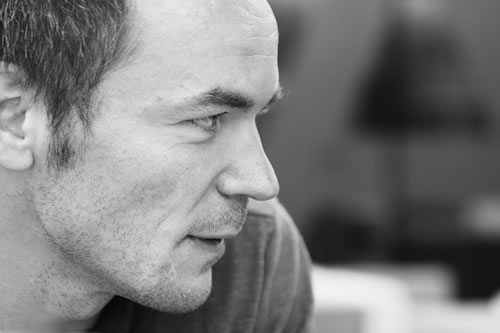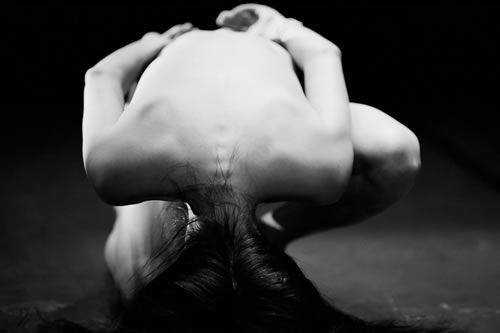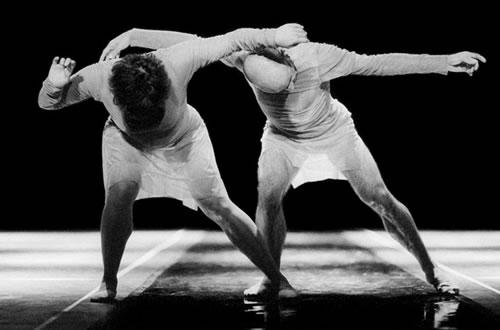Spotlight on Dance II
Un|still: An Interview with Laurent Ziegler
As part of the 2006 Dance festival Beyond the Waltz, photographs of the Austrian photographer Laurent Ziegler's dance collection un|still are on view at the Austrian Emnassy in Washington, D.C. Austrian Information took the opportunity to talk to him about his work.
AI: How do you choose your dance company or dancers? Or do they choose you?
Sometimes I pop into a dance performance without knowing much about the artistic work, just out of curiosity. This is the best way to be surprised. However, I know a number of dance companies I would travel a long way in order to see them.
It is difficult to gain permission to photograph. Many dancers work and create in a very secluded environment and a single 30 minutes photo rehearsal prior to a show never satisfied me. Like in most other areas, all is about connections and it takes years to build a solid network - and even more to build a good reputation.

Laurent Ziegler. Chris Zvitkovits
AI: How do you accomplish your photographic series? Do you spend long periods of time to complete them?
In the beginning I struggled defining the borders of a particular series. I just grabbed my camera and started xploring dance with as many rolls of film as I got a hold of.
Today, I work more conceptually in the sense that I define what I am looking for, a clear language that I wish to communicate. I am still open for surprises and changes. My interest shifted from the more traditional stage photography to the private area, sometimes off limit to the public eye, with less distance and the ability to approach the dancer in the most reduced and direct way. It is not my aim to manipulate moments or a certain quality - but to attend the scenery and witness all that is going on.
Dancer Akemi Takeya, Vienna 2006. Laurent Ziegler
AI: Why dance or performances? What can you explore and achieve through them that you cannot with other subject matters?
Dance photography - it was not planned at first place. After having completed my studies I worked as an editor in a very non-artistic environment. At some point I realized that my desire was somewhere else and decided to alter my daily routine. I enrolled in press photography and in the late 1990s had the opportunity to shoot dance for the first time. I was deeply moved by the sincerity and grace that opened up in front of my eyes. I felt as if I found what I had been looking for all my life - a new territory where borders shift and moments hold the opportunity for exploration, chaos and risk. I auditioned for a modern dance school and enrolled in a five year dance program that I completed in 2004.
No need to say I love to watch new work on stage but I don't necessarily feel attached to every performer. Some companies work in a purely abstract way, others solely on a physical level. What I am looking for is less an aesthetic survey on the male and female body but communicating stories and touching the viewer. It requires the dancer to be fully open and connected to the moment, there is no yesterday or tomorrow, there is just the moment that is lived and inhaled in all possible ways. To me, this is where art begins to exist, to breath. Such performances happen only once in a certain way. A repetition is not possible.
The same goes for the photographer. Every shot is a one-time-chance. Let me quote Minoru Hatanaka, saying about the Tokyo based performance group Dump Type that it is all about "a move from an attitude of viewing to that of experiencing the piece bodily." The founder of Dump Type, Teiji Furuhashi once stated, that "The important thing is not in remembering words, but in how you yourself recompose these words into reality - in how you make memories into something of your own." I couldn't find better words. I am offering an image, my personal interpretation of an ongoing process. The spectator is asked to recompose the image into his or her own landscape of perception and understanding.
Why dance... Fitting a cliché, I would say it is for the beauty of it. But when I talk about beauty, I am not talking about prettiness. A pretty picture is not necessarily beautiful. Beauty inherits both, dark and bright aspects of one soul and that is where the story begins. Such beauty is not limited to dance. It certainly is not. I find beauty everywhere, depending on what I am open to look at, what aspect of reality I am drawn towards to. A fruit seller on a market can be the most touching artist and beautiful in the way he puts together a pile of oranges. So does a child, passionately drawing on a piece of paper, or a couple kissing good-bye. Dance is everywhere and the world is a single stage by itself, once there is a decision to perceive it in such a way.
Dancers Emio Greco and Barbara Meneses Gutierrez, Vienna 2005. Laurent Ziegler
AI: You refer to your photographs as un-still, the movement is captured in the immobility of your images, what is the intrinsic meaning of this?
Yes, I guess it is about the immobility of images to move since a picture is a still. And yet such captured moments move very much, indicating time and change. un|still is also the title of a web project I started in the late nineties. At www.unstill.net you find a selection of recent work, put up as some kind of virtual gallery to wonder through and to explore.
AI: Have you ever thought about combining photography with performances or video installations?
I began designing concepts for video installations in 2005. I am currently preparing a performance piece for two dancers, Sengiku Bando and Ryohei Kondo, both based in Tokyo. The project aims at opening up the traditional settings of a theatre and creating a story telling with various spacial and visual entities. The artists and the spectators share the same space and travel along given points, indicating the passing and alteration of time. Video walls are set up as an additional carrier, pre-recorded memory based material is put on the same time horizon with the live performance.
AI: Have you been able to achieve through photography what you are striving for?
Even in our over saturated world, photography remains a powerful media,versatile in every way. With my recent work I feel able to communicate stories, touch people and have them taken by surprise for a single moment. This is my biggest goal, to reach out and have a spectator discover something unexpected, a language that might be unknown and yet is fully understood from the inside.
AI: Mr. Ziegler, thank you for this interview.
More information on Laurent Ziegler and his photography is available on the artist's web site: www.unstill.net


